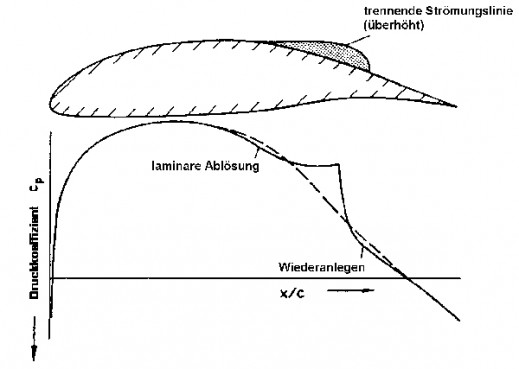Boundary layer blowing
Modern wing profiles get their low drag characteristics due to the fact that air passes along a large part of the wing chord as a low friction, layered stream. This so-called “laminar” characteristic of the near-surface airstream is optimized when the thickest part of the wing profile is moved back along the chord. However, this means that the profile needs to get thinner again over a shorter distance, to attain the profile thickness near the trailing edge. Also, in this area the static pressure has to be increased again to reach ambient atmospheric levels.
If the pressure increase is too high, the laminar flow separates, resulting in many eddies and flow reverses. Laminar flow’s disadvantage is that it can only tolerate lower pressure increases than a turbulent air flow. When laminar low separates it changes to turbulent flow and again follows the profile contour if the angle of attack is relatively low. It may even remain attached without separating a second time. This phenomenon is known as the “separation bubble” and it disturbes the profile’s air velocity and pressure distribution and leads to increased drag.

(contrary to the drawing, on our wing profiles the bubble forms on the lower wing surface!)
A solution to deal with this situation becomes readily apparent: to avoid the high drag bubble, the close to the surface laminar flow must be turned into turbulent flow shortly before the separation point. Although the friction drag of turbulent flow is higher than that of laminar flow, it is lower than that of a separation bubble.
Normally zig-zag tape, dimple tape or blowhole turbulators (DLR patent) are used as turbulators. Blowhole turbulators are fine holes in the wingskin through which air is blown. This air is supplied to the blowholes via a channel in the wing.
The channel is supplied with air by means of NACA-ducts or pitot tubes in the airflow. The advantage of the blowhole turbulators is that they are still effective even when they are already located in the separation bubble. Also, a NACA duct is a very efficient and low drag solution to take the necessary air from the airstream. It is located inside the wing contour and cannot be easily damaged. In addition, blowhole turbulators and NACA ducts do not interfere with bug wiper retrieve cables.
